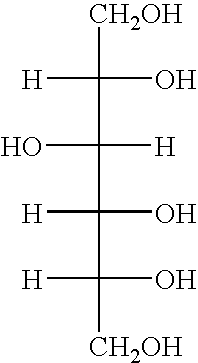Methods of using stable ascorbic acid compositions
a technology of ascorbic acid and composition, applied in the field of methods, can solve the problems of poor wound healing, poor stability, edema, etc., and achieve the effects of excellent stability, excellent stability, and satisfactory shelf li
- Summary
- Abstract
- Description
- Claims
- Application Information
AI Technical Summary
Benefits of technology
Problems solved by technology
Method used
Image
Examples
examples
[0053]Example 1 below shows suitable compositions in accordance with the present disclosure.
Ingredient% of solution (w / v)Water60–96Sorbitol 70%0.1–10 Ca Hydroxide0.10–0.5 Zn Chloride0.10–2 Na Hyalurate0.001–0.02 Ascorbic acid 5–40SLS (30% solution)0–5Phenoxyethanol0.1–1 Fragrance0.0–5 Alkydimethylbenzylamine0–5
[0054]Example 2 below shows other suitable compositions in accordance with the present disclosure.
Ingredient% of solution (w / v)Water 60–96Reducing Sugar 0.1–10Metal Salt or mixtures thereof0.10–5 Moisturizing Agent 0.0–0.02Ascorbic acid 5–40Antimicrobial0.0–1Surfactant0.0–5Fragrance0.0–5
[0055]The compositions of the present disclosure may be packaged in suitable containers such as tubes or bottles. Suitable containers are commercially available from a variety of suppliers. A wide variety of containers and suppliers are listed in the CPC Packaging Directory. (See, Buyers' Guide under “Containers” at www.cpcpkg.com). In embodiments, containers are selected with low oxygen ...
example 3
[0056]In vitamin C compositions without reducing sugar, an aqueous solution of 5% ascorbic acid will likely decompose to less than 90% of the concentration at room temperature in 4 weeks time. See for example U.S. Pat. No. 4,983,382 the entire disclosure of which is incorporated herein by this reference.
[0057]Conversely, the stability of compositions made in accordance with the present disclosure show improved stability. Such compositions were evaluated by placing aliquots of each example in an oven at 5, 25, 30 and 40 degrees Centigrade for predetermined time periods and at the end of each time period analyzing the amount of vitamin C present in the composition.
[0058]The following results were observed with compositions in accordance with example 1 having 20% initial vitamin C concentration, sorbitol 70%, Ca hydroxide, Zn chloride, Na hyaluronate 1%, SLS (30% solution), phenoxyethanol and fragrance.
Stability of formulation ofexample No. 1% Vitamin CInitial amount of ...
example 4
Percutaneous Absorption Study:
[0059]The in-vitro percutaneous absorption of vitamin C formulations were compared using intact human cadaver skin. Cumulative transdermal absorption of radiolabeled [14C] L-ascorbic acid was measured at 24 hours. The human cadaver skin was obtained from a single donor and dermatomed to approximately 500 micron thickness. The skin samples were mounted on Franz static diffusion glass chambers. The skin surfaces of approximately 1.77 cm2 were washed with 0.5 ml of water at 37° C. for 10 seconds. The water was aspirated and the surface pad dried. The following treatments were performed.[0060]Treatment A. 15 mg of a formulation in accordance with example 1 having 25% ascorbic acid, reducing sugar, and metal ions was applied to 1.77 cm2 of human cadaver skin samples.[0061]Treatment B: Skin pretreated with 15 mg of pretreatment solution (5% benzalkonium chloride, a cationic salt). The skin was dried, and then 15 mg of formulation of Treatment A was applied to...
PUM
| Property | Measurement | Unit |
|---|---|---|
| v/v | aaaaa | aaaaa |
| viscosity | aaaaa | aaaaa |
| specific gravity | aaaaa | aaaaa |
Abstract
Description
Claims
Application Information
 Login to View More
Login to View More - R&D
- Intellectual Property
- Life Sciences
- Materials
- Tech Scout
- Unparalleled Data Quality
- Higher Quality Content
- 60% Fewer Hallucinations
Browse by: Latest US Patents, China's latest patents, Technical Efficacy Thesaurus, Application Domain, Technology Topic, Popular Technical Reports.
© 2025 PatSnap. All rights reserved.Legal|Privacy policy|Modern Slavery Act Transparency Statement|Sitemap|About US| Contact US: help@patsnap.com



